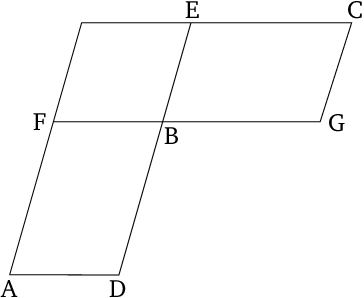In equal and equiangular parallelograms the sides about the equal angles are reciprocally proportional. And those equiangular parallelograms in which the sides about the equal angles are reciprocally proportional are equal.

Two parallelograms are congruent if and only if their angles and the products1 of the side lengths of an angle are in both paralleograms equal.
$$\begin{array}{rclc} \boxdot{ADBF}\cong\boxdot{BCEG}&\Longleftrightarrow&(\angle{ADB}=\angle{BGC})&\wedge\\ &&(\angle{FAD}=\angle{EBG})&\wedge\\ &&(|\overline{DB}|\cdot|\overline{BF}|=|\overline{BE}|\cdot|\overline{GB}|). \end{array}$$
Proofs: 1
The product is equivalent to Euclid's "reciprocal proportion" $$\frac{|\overline{DB}|}{|\overline{BE}|}=\frac{|\overline{GB}|}{|\overline{BF}|},$$ which is not to be confused with the concept of reciprocal ratio. ↩